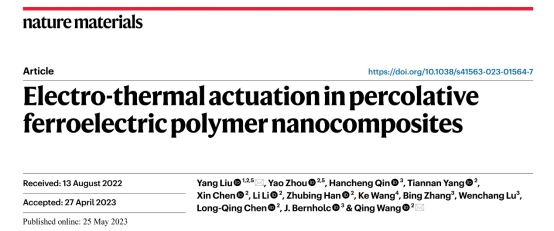On May 25th, a research paper titled “Electro-thermal actuation in percolative ferroelectric polymer nanocomposites” was published online in Nature Materials, which was jointly conducted by Prof. Liu Yang from the School of Materials Science and Engineering of HUST and Wang Qing from the Pennsylvania State University. This paper reveals the use of electro-thermal actuation to achieve high strain and mechanical energy density, which compares favorably with piezoelectric ceramics and crystals. Research briefing in Nature Materials also report the main finding of this work entitled “Polymer actuation using a Joule-heating-induced ferroelectric phase transition”.

Low-cost, light weight, flexible ferroelectric polymers and nanocomposites enable flexible, wearable and biocompatible devices in acoustic sensors, transducers and actuators. The trans-gauche conformation is switched to the all-trans conformation of poly (vinylidene fluoride) in response to the applied field which gives rise to strains. The driven electric field is usually extremely high about 500 MV/m. Although ferroelectric polymers exhibit much larger strain responses (~8%), the output mechanical energy densities and the actuation strength (defined as the normalized elastic energy density in an electric field) of the current ferroelectric polymers and composites are significantly lower than those of piezoelectric ceramics and single crystals, limiting their applications in soft actuators. It remains a central challenge to design novel actuation modes which exhibit high strain and mechanical energy density in a low electric field.

In this context, the team reports the use of electro-thermally induced ferroelectric phase transition in the percolative ferroelectric polymer nanocomposites to achieve superior actuation performance in terms of strain (8.1%) and mechanical energy density (11.3 J/cm3) to those of the benchmark piezoelectric ceramics and single crystals. This work presents a paradigm shift for achieving large strains and ultrahigh elastic energy densities in ultralow electric fields in ferroelectric polymer composites for flexible electroactive devices.
To overcome this challenge, inspired by the actuation of shape memory alloys that is based on the martensitic phase transition triggered by Joule heating, the team employs an electro-thermal approach to drive the ferroelectric phase transition in PVDF-based nanocomposites near the percolation. Distinctly different from the current ferroelectrics whose actuation is driven directly by the applied electric field, the ferroelectric phase transition reported in this work is driven by Joule heating. With the application of an electric field, adequate Joule heating is generated from the percolated nanofillers, which would subsequently induce the phase transition of PVDF and thus giving rise to a large strain response. As a result, the applied electric field in the electro-thermal phase transition is less than 10% of the magnitude of the field required to induce the ferroelectric phase transition in poly (vinylidene fluoride). The composite displays nearly no strain degradation up to 105 cycles. The proposed electro-thermal approach enriches the design of ferroelectric phase transition and creates a new opportunity for optimizing the functionalities of ferroelectric materials.
Paper link: https://www.nature.com/articles/s41563-023-01564-7
Source: School of Materials Science and Engineering
Written by: Liu Yang
Edited by: Chang Wen, Peng Yumeng
